Do Gutter Guards Work?
Gutter guards are important to the maintenance and upkeep of your home. And yes – They work if you get the RIGHT gutter guard.

Gutter guards should work by keeping debris and other intrusive elements out of your gutter system while allowing water to flow into the gutter system, down the downspout, and away from the foundation of your home. Whether different types of gutter guards work is often dependent on the type and amount of debris falls unique to each home. The goal is to find one that works in all situations.
While gentle rain on a Sunday afternoon can be cozy and relaxing, heavy rain can end up causing overflowing gutters and forming dams and puddles close to your foundation or even worse, seeping into your basement.
Effective gutter guards installed over your existing gutters are important as they help to control the flow of water around your family’s home while preventing any debris buildup that would lead to blocked gutters.
How the right gutter guard is beneficial for you and your home:
- Ending gutter clogs – Limiting your stress about home maintenance
- Keeping homeowners off ladders- helping to keep you safe
- Directing water away from the home – protecting one of your largest investments
Different Types of Gutter Guards and How They Work
There are many different design styles of gutter guards on the market, from inserts and stainless steel micro mesh to leaf guard gutter guards and gutter helmets.
And with so many gutter cover variations, it can be quite difficult to decide what’s best for you.
Here’s a closer look at some of the most popular designs on the market and what to expect from each:
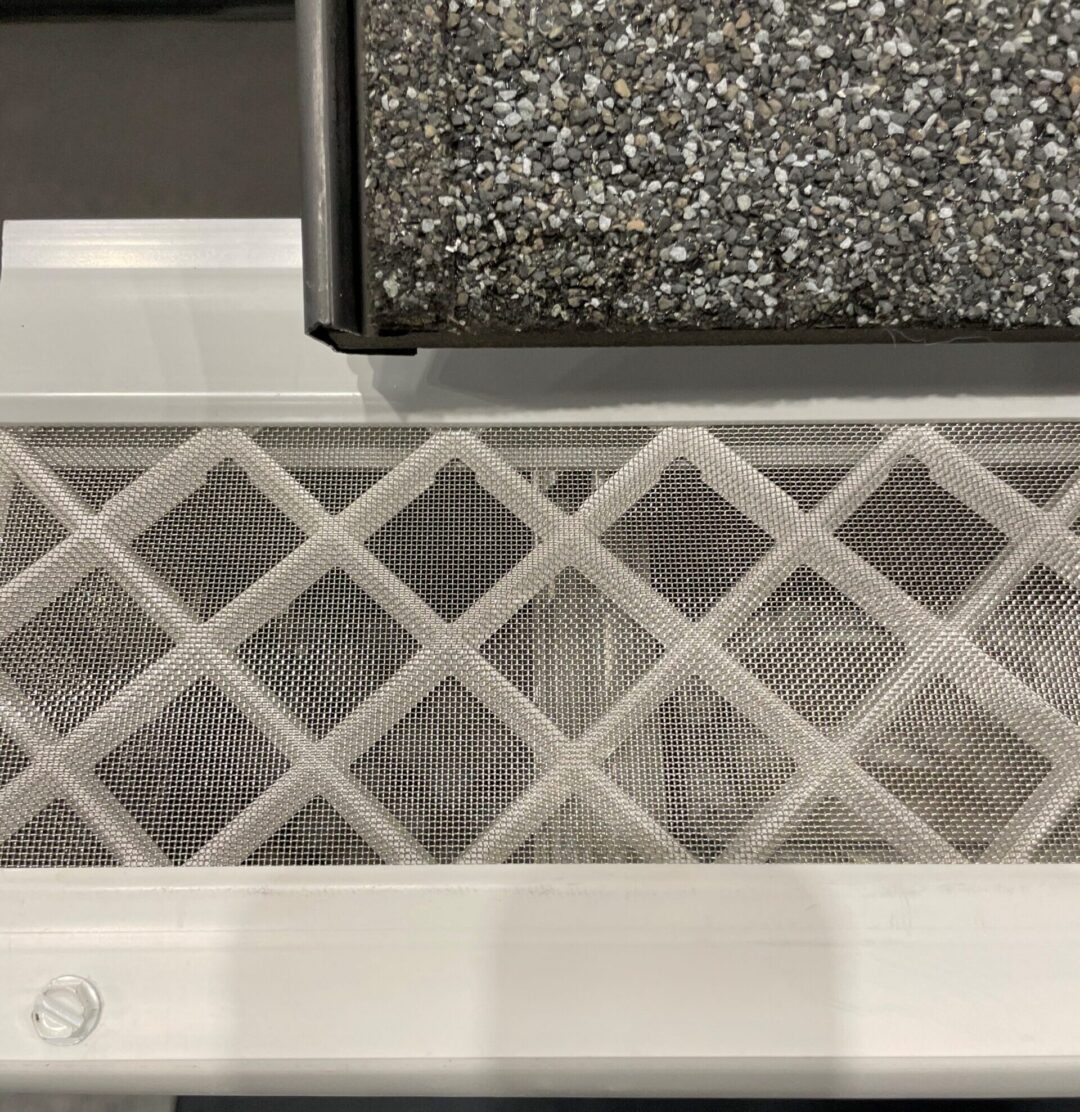
Micro Mesh Gutter Guards
A micro mesh gutter guard is a gutter protection system usually made of non-corrosive materials such as aluminum or stainless steel. The micro-mesh screen is usually attached to a uPVC frame and is installed over the top of the gutter.
These micro mesh guards have very small holes which stop even small debris from entering the gutter and when clean, allow water to flow through the mesh into the gutter.
The micro-fine mesh openings do, however, present a challenge as they can potentially collect debris on top causing the mesh itself to clog. If there are trees overhanging the home and dropping sap, pine needles, petals, and other debris, eventually it can become too blocked to allow water into the gutter.
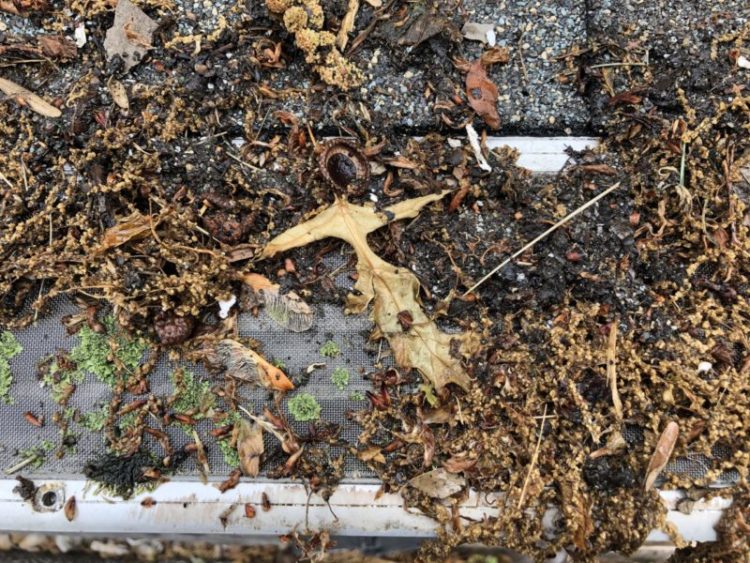
This is often the case when they’re fitted to homes in suburban areas that are known to have large oak trees. That’s because these trees regularly shed long tassels which end up getting clogged in the mesh covers. This results in the micro mesh being too clogged to allow water to pass through and overflow the gutter.
So unless there are no trees close to the home, or very little debris, micro mesh gutter guards may not have a lasting value as the homeowner is left maintaining the system by getting on a ladder and scraping the mesh clean.

Foam Guards
Unlike mesh guards that cover the opening to the gutter system, foam guards are designed to sit inside the gutter.
That’s right, this product actually takes up the space intended for water flow. So this can impede the gutter capacity.
It allows water to flow through its porous foam while preventing debris like twigs and leaves from entering the system.
On the upside, this type of gutter guard is super easy to install. They come in a standard size which should fit easily inside the actual gutter, with the minor trimming to length by the homeowner all that is required.
The issue, however, with foam guards is that it’s pretty good at keeping the larger debris out, but pretty ineffective at keeping the smaller things like seeds and tassels clear of the gutter system.
The smaller debris often piles up on top of the foam to the point of corroding, forming a sticky layer of goo on top of the foam gutter guards.
And like with the micro mesh guard, this particular system will also need regular maintenance and upkeep to work effectively.
Brush Gutter Guards
A brush gutter guard system is made up of a series of bristles and brushes that fit inside your gutter system.
These brushes are usually made of a durable material like nylon, so they do tend to last quite a long time.
They work by catching debris and larger refuse in the brush itself while allowing water to flow freely through the system.
Aesthetically they offer very little to the look and feel of a home, just like the previously mentioned design models.
And the drawbacks with this type of system are often the same as with the other designs – clogging. Oh, how we hate clogged gutters!
Brush gutter guards are quite a strange design if you take the time to actually think about it.
The brushes are designed to catch small debris like leaves, twigs, pine needles, and tassels.
But what happens to all that debris once it’s caught in the brushes?
They eventually pile up and form a solid barrier. And so again, you’ll need to climb a ladder for occasional cleaning to make sure that the system still works as it should.
Reverse Curve Gutter Guards
Reverse curve gutter guards have a solid cover that creates a roof over the opening of your existing gutter system. The top of the guard should be smooth with no texture to easily allow debris to slide or blow off. Compared to the texture of screens, meshes, foam or brush gutter guards, this slick surface is a huge advantage when it comes to maintenance.
Solid cover? That’s right, rather than holes or mesh to allow the water in, the top is a solid sheet of metal that blocks debris from entering the gutter.
That might seem silly at first, but it works. Solid reverse curve gutter guards are designed to harness the natural characteristics of water bonding to a surface, the water follows the reverse curve design around the nose of the gutter guard and into the gutter below.
Perhaps that idea seems a bit farfetched, but to illustrate, try this experiment with a flat plate and a curved bowl.
As you rinse the plate under running water, you’ll notice that the water flows down the surface of the plate clinging to it, and then falls off. However, when you rinse the curved bowl under the same running water, you’ll observe that the water clings to and follows the curves of the bowl before it drops off, even as you increase the flow of water.
In this example, the plate surface and curved surface of the bowl promote surface tension, causing the water molecules to adhere to the surface instead of immediately falling off.
The cohesive properties of water make it stick to a surface, creating a film of water along the surface. This phenomenon is similar to what happens with a reverse curve gutter guard. Even in heavy downpours!
Surface tension is what causes the water to cling to the curve of the gutter guard and follow it until it enters the gutter system.

Reverse Curve Gutter Guards Work Well At Blocking Debris, But Some Have Design Flaws.
If the nose of the guard does not cover the gutter completely, it can allow debris into the gutter. Some solid guards are designed with a slot or channel on the back side close to the roofline which allows water in, this slot can become clogged.
Various solid gutter guards or gutter helmets are glued to the roof, which can cause damage if it needs to be removed. Some solid guards are installed over roof shingles and are not attractive.
Some leaf guards are all-in-one design with gutter and guard connected as one piece, and some are smaller than a normal gutter size. While an all-in-one seamless design might seem like a great idea, it requires existing gutters to be replaced. Also, if a tree limb falls on a section, the whole length of gutter and guard is going to have to be replaced. Whereas, if it were installed in smaller pieces, only the damaged section, and possibly only the guard would need replacement. In addition, if the design is smaller than a normal size gutter, it may not keep up with large amounts of water, especially valleys.
Another factor to consider is appearance. When the gutter and guard are the same color, as is the case in all-in-one systems, it may not blend as well with the roof as when the guard matches and blends seamlessly with the roof, giving a trimmed appearance to the the roofline.
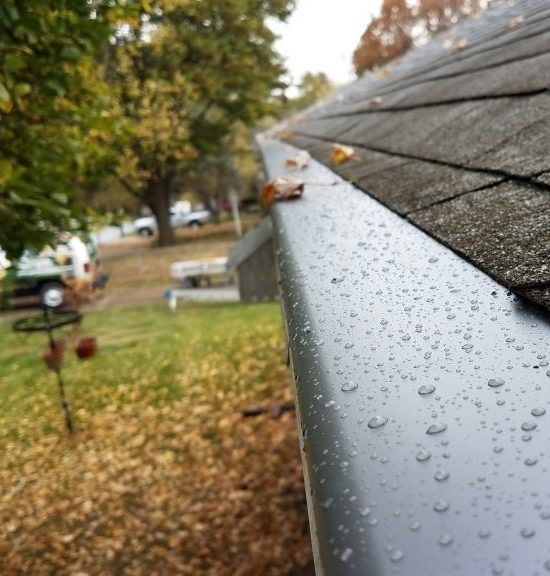
Advantage Gutter Guard®: The Right Gutter Guard For Your Home.
Why? It has a nose-forward design that completely covers the gutter opening, blocking all debris. Smooth and solid on top, with no texture, and no slots, channels or openings. It comes with a Lifetime No Clog Guarantee.
It is made of heavy gauge, rust-proof aluminum, and no plastic parts. The patented, sturdy all-metal bracket does not attach to or penetrate the roof. Third-party tested to handle 122 lbs. of pressure per linear foot, it PROTECTS GUTTERS FROM THE WEIGHT OF ICE AND SNOW. To put that into perspective, it can support 4 feet of solid ice, or 12 feet of snow stacked on top of it.
It handles 3X the amount of rainwater of an average rainstorm. The sleek, low profile, virtually invisible guard complements and adds to the beauty of any home. It installs on normal size 5 or 6-inch, new or existing guttering. Available in multiple colors or copper. It is versatile and can be installed beautifully with any type of roof. Advantage Gutter Guard even installs on half-round gutters. It is installed in sections on new or existing guttering and is not all-in-one.
What is the maintenance?
Any gutter protection will require some maintenance. Some more than others. The important aspect to look for is what gutter guard requires the least maintenance and effort. If cleaning the leaf filter or guard is as difficult as cleaning the gutter, then there is no real benefit.
The smooth surface of Advantage Gutter Guard makes it low and easy maintenance that can be done from the ground. Most debris will slide past the guard or blow off.
In heavily treed areas, or with specific debris such as sticky, glue-like oak tassels, there may be a collection of the tassels or other debris, sticking to the cover or in the roof valleys, especially in the spring. Simply knock this off with a long-handled broom or hose from the ground. With lesser debris, we recommend a yearly rinse with a hose to knock off dirt and dust.
That is simple, and way less work than standing on a ladder cleaning out gutters or mesh, screen, filter, brush, or foam gutter guards.
How Different Gutter Guards Work Handling Debris
Some of the standard debris that you can expect to clog – or not clog your system – includes leaves, twigs, branches, pine needles, whirly birds, ash needles, oak tassels, and seeds.
We’re all pretty used to seeing those culprits regularly causing our gutters to overflow. But here are a few of the less common, yet equally intrusive types of debris that you need to be wary of:
Blossoms and Petals
Brush guards can become easily clogged with blossoms and petals, impairing their ability to allow water through. Gutter screens and mesh also accumulate this lightweight debris, leading to reduced water flow and potential blockages.
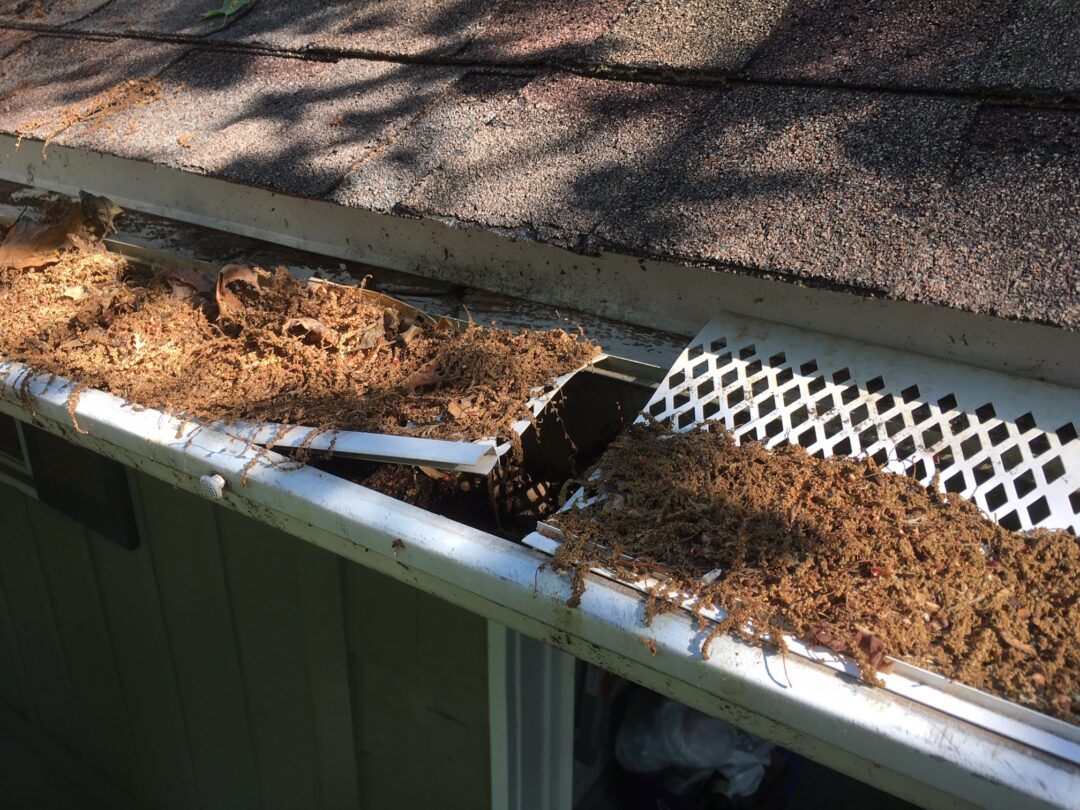
Foam guards will also collect blossoms and petals, rendering them less effective over time. Solid guards do a good job of blocking blossoms and petals from entering the gutter and causing a clog, unless there is a large gap or opening at the front where the water enters, which can allow debris in as well. To prevent this problem look for a nose forward solid guard design that blocks debris from entering the gutter. Also watch for any type of opening on the top, like a channel at the back of the solid guard.
Moss and Algae
Brush guards, gutter screens, micro mesh, and foam guards do not provide sufficient protection against the growth of moss and algae.
These guards often have open spaces or porous materials that allow organic matter to accumulate and provide a favorable environment for moss and algae to feed on. Solid metal guards block debris from entering the gutter rather than allowing a buildup of debris for moss and algae to grow on.
Animals and Nests
Brush guards and foam guards are easily pulled out by squirrels and other critters.
Gutter screens and some mesh type guards may not be secure enough to prevent being pried out by animals. Additionally, all four types of guards may not effectively deter birds or small animals from building nests in the gutters or on top of the guard. Some solid guards may even have a big enough opening for a bird to squeeze in and build a nest. Advantage Gutter Guard® blocks birds from entering the gutter by it’s nose forward design and end caps that prevent entry.
So How Can You Deal With All These Various Types of Debris?
While brush guards, gutter screens, and foam guards may offer some level of debris protection, they often have limitations in handling various types of debris and can be less durable or prone to clogging.
A solid reverse curve gutter system, like the Advantage Gutter Guard, provides more reliable and effective protection against a wide range of debris, making it the right gutter guard choice for homeowners seeking long-term gutter clog prevention.
Do You Really Need Gutter Guards?
While gutter guards are not absolutely necessary for every home, they do have numerous benefits, which makes them not only a smart choice but also a long-term investment that can help maintain the value of your home.
With the best gutter guards professionally installed, you can safeguard your gutters from unwanted debris while ensuring water is safely and effectively diverted away from your home. Enjoy peace of mind knowing your home is protected.
By allowing your gutters to channel rainwater away from walls, windows, and basements, gutter guards prevent potential water damage that could diminish the value of your property and be very costly.
What is the Best Gutter Guard?
We all love a good Kansas City thunderstorm. But how does your gutter system handle all that rainwater?
A good gutter guard system will allow water to flow down the downspout and away from your foundation.
But a great gutter guard system will excel where other systems fall short. And that’s exactly what the Advantage Gutter Guard does. It’s been designed to handle up to three times the water volume of the average Kansas City rainstorm while easily dealing with unwanted debris.
Is heavy rain in the forecast? We say bring it on!
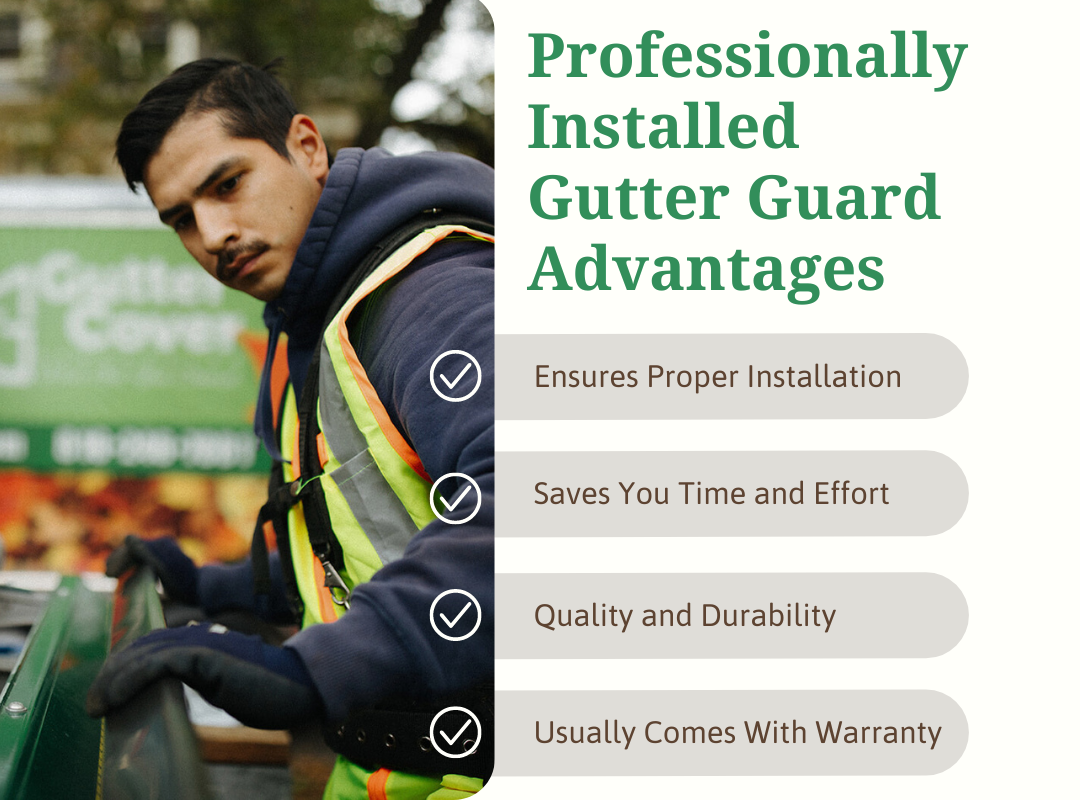
DIY Gutter Guards vs Professional Installation of Gutter Guards
While DIY kits may seem cost-effective initially, they can lead to potential issues in the long run. Here are just a few of the advantages of professionally installed gutter guards.
Firstly, they ensure proper installation.
Gutter guards need to be correctly installed to maximize their effectiveness. A professional gutter company has the experience and expertise to assess your specific needs, recommend the best gutter guards for your situation, and install them correctly.
This guarantees that the gutter guard system works effectively, keeping the debris out of your gutters.
Secondly, professionally installed gutter guards save you time and effort.
DIY installation can be time-consuming and challenging especially if you have no previous experience in gutter work. Professionals have the necessary tools, knowledge, and skills to complete the installation quickly and accurately, freeing you from the hassle of figuring things out for yourself.
Last but not least, there’s quality and durability in a professionally installed system.
DIY kits often provide basic options like mesh or foam gutter guards. Which may not be as effective or long-lasting as other types of gutter guards. They usually do not come with a warranty.
Professional installers, like Gutter Cover KC, can offer you the very best that gutter guard technology has to offer. These higher-quality options will also come with guarantees and warranties.
Clearly then, while a DIY kit offers short-term solutions to the weekend warrior out there, professionally installed systems make way more sense to the discerning homeowner.
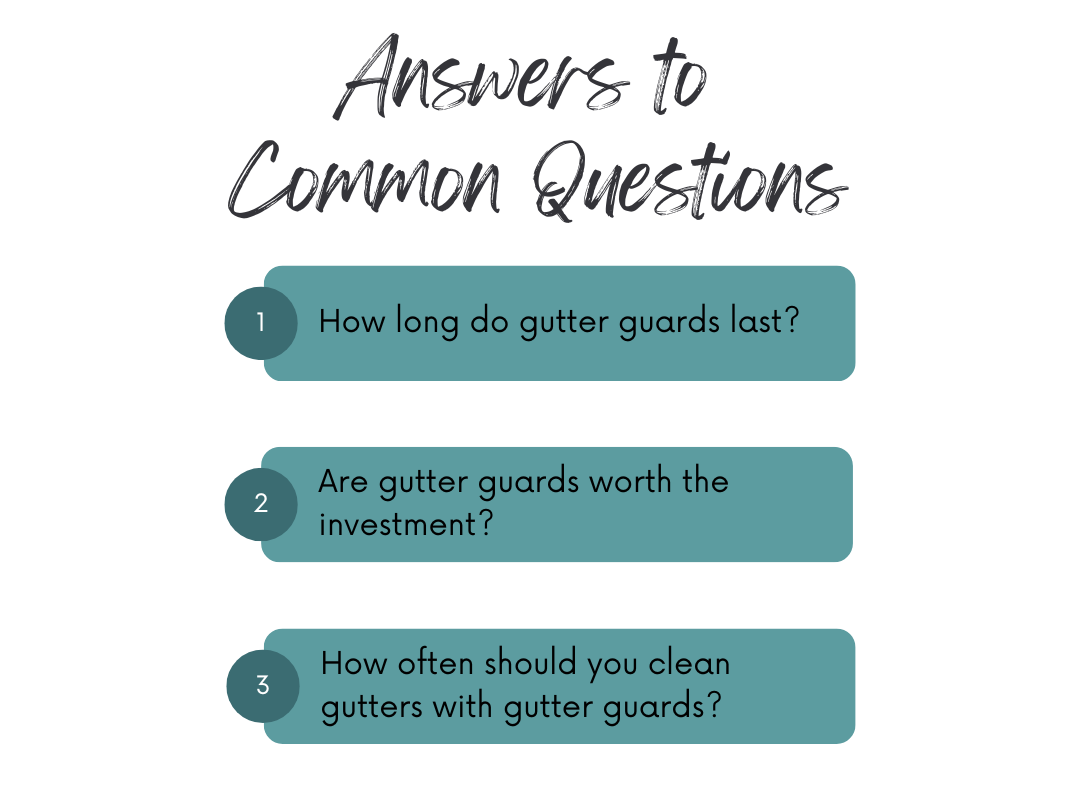
Important Questions Answered When Considering Gutter Guards
Thinking of installing gutter guards to your existing gutter systems? You might have some important questions that need answering. Consider the following:
How Long Do Gutter Guards Last?
Gutter guards are generally designed to be durable and long-lasting. Their lifespan can depend on varying factors. Such as the quality of the materials used in construction, the local environment, and how professionally the installation was carried out.
When it comes to longevity, the Advantage Gutter Guard stands out as one of the best options available. It has a high-quality construction and superior design which makes it exceptionally durable.
This system has been engineered to withstand harsh weather conditions and resist corrosion. Ensuring a long lifespan for your gutter system. Advantage Gutter Guard® is professionally installed safeguarding your biggest investment from the elements.
Are Gutter Guards Worth the Investment?
Yes, Gutter Guards are worth the investment for many homeowners.
By reducing the debris intake into your gutter system, they save you on time, effort, and the possible risks associated with climbing ladders to clean out existing gutter systems from time to time.
By blocking out small and large debris, they maintain the efficiency of your rainwater filtration system. This, in turn, reduces the likelihood of water damage, and potentially costly repairs.
So while there are initial costs involved in purchasing and installing gutter guard systems, the long-term benefits make them a worthwhile investment.
How Often Should You Clean Gutters With Gutter Guards?
When it comes to gutter cleaning with gutter guards, it’s important to note that different types of gutter guards, such as screen, foam, and mesh guards, may still require regular cleaning to prevent debris buildup. If cleaning the gutter guard is as much work as cleaning the gutters it is not doing the job.
However, there is a superior solution available for keeping your rain gutters clean. The Advantage Gutter Guard, offered by Gutter Cover KC, is a highly effective gutter guard system that eliminates the need for frequent cleaning.
With its innovative design, the Advantage Gutter Guard effectively keeps out leaves, twigs, and other debris, even during heavy rain.
Say goodbye to the hassle of cleaning gutters or screen, foam, or mesh guards, and welcome the convenience of the Advantage Gutter Guard. Enjoy clean and debris-free gutters with minimal maintenance.
Fill out our form below to start your free no hassle estimate.
In the end, why does keeping your gutters clean even matter? Why is finding the right gutter guard that works so important?
Gutter Cleaning – Why It’s Crucial to Maintaining Your Home
Gutter maintenance is crucial to ensure the optimal performance of your gutters and prevent various issues.
Regular upkeep and cleaning are necessary to avoid water damage, especially to your home’s foundation. Clogged or damaged gutters can cause water to overflow and accumulate near the foundation. This can lead to structural problems and basement flooding.
More than that, neglected gutters can result in roof damage. Including leaks and shingle deterioration, as water backs up onto the roof or into the soffit and fascia. This can also harm the siding, windows, and exterior surfaces when water cascades down the sides of the house. In addition, it can backflow into the home staining ceilings, and causing moisture damage and mold if not quickly addressed.
So, What’s Involved In Performing Gutter Maintenance Yourself?
Well, gutter maintenance typically involves several tasks.
First and foremost, regular cleaning is necessary, preferably twice a year, in the spring and fall. This involves clearing out leaves, debris, and any obstructions from the gutters and downspouts. Depending on how many trees, whether they overhang the house, and the type of debris they drop your gutters may require cleaning several times a year.
Secondly, it’s important to conduct regular inspections to identify any signs of damage like leaking seams, sagging, and loose fasteners. Promptly addressing these issues can prevent further damage.
If repairs or replacements are needed, take the necessary steps to maintain the gutter system’s functionality.
Don’t forget to ensure that downspouts are free of debris and properly directing water away from the foundation. One effective solution to reduce the frequency of maintenance is installing an effective, low-maintenance, gutter guard system.
Gutter cleaning involves ladder risk. Follow ladder safety recommendations.
